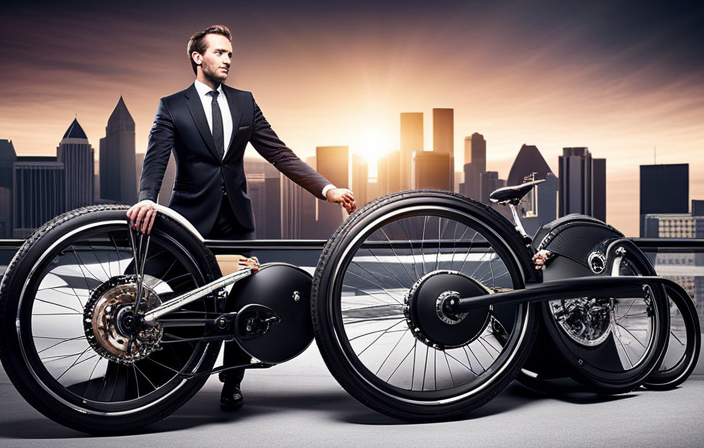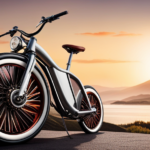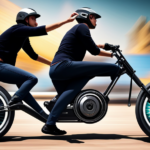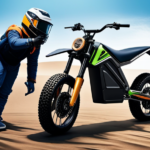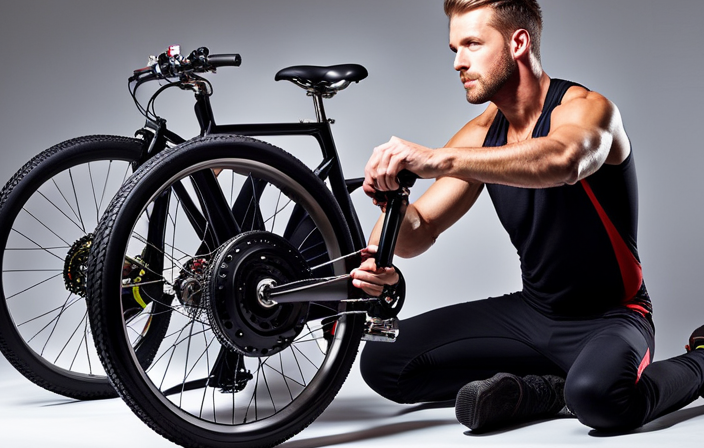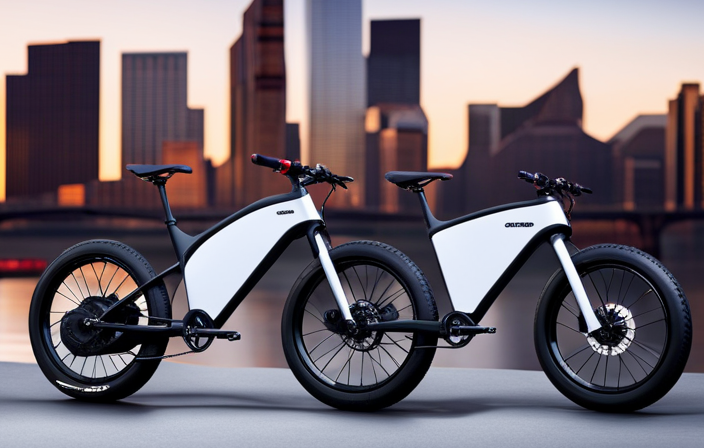I’ve always been fascinated by the mechanics behind electric bikes. How do different electric bike kits work?
Well, let’s dive into the world of hub motors, mid-drive motors, battery systems, controllers, and sensors.
We’ll explore the differences between pedal-assist and throttle-controlled kits, and learn how conversion kits can transform any regular bike into an electric one.
Plus, we’ll discuss safety features, maintenance tips, and how to choose the right electric bike kit for your needs.
Get ready to take your biking experience to a whole new level!
Key Takeaways
- Regenerative braking converts kinetic energy into electrical energy and increases energy efficiency.
- Conversion kits can transform regular bikes into electric bikes, offering flexibility in assistance and power levels.
- Safety features such as powerful brakes, LED lights, and reflective gear ensure a secure riding experience and reduce the risk of accidents.
- When choosing an electric bike kit, consider factors such as riding style, desired speed, budget, battery capacity, and motor power for optimal performance.
Hub Motors: How They Power Electric Bikes
Hub motors are what power electric bikes. They work by integrating the motor into the wheel hub. This design offers several advantages. Firstly, it improves efficiency and ease of use. Hub motors are known for their high efficiency because they directly drive the wheel without any additional components. This means that power is not lost in transmission or conversion, resulting in a more efficient use of energy. Additionally, hub motors provide a smooth and quiet ride since the motor is directly connected to the wheel.
However, there is one drawback to hub motors. Their weight distribution can be a problem because the motor is located in the wheel. This can make the bike feel unbalanced and affect maneuverability.
Now, let’s take a closer look at the functionality of mid-drive motors.
Mid-Drive Motors: A Closer Look at Their Functionality
Take a closer look at how mid-drive motors function and their functionality.
-
Pedal efficiency: Mid-drive motors are designed to provide optimal power transfer from the motor to the drivetrain, resulting in improved pedal efficiency. This means that you can pedal with less effort while still enjoying the benefits of electric assistance.
-
Torque sensing: Mid-drive motors use torque sensors to measure the force applied to the pedals. This allows the motor to provide assistance proportionally to the rider’s effort, creating a more natural and responsive riding experience. As you pedal harder, the motor provides more assistance, and as you pedal lighter, the motor reduces its output.
-
Versatility: Mid-drive motors are highly versatile and can be used in various types of electric bikes, including mountain bikes, road bikes, and commuter bikes. Their central location in the frame provides better weight distribution and improved handling.
Now, let’s delve into the next section about battery systems: fueling your electric bike.
Battery Systems: Fueling Your Electric Bike
Battery systems power electric bikes and are essential for fueling your ride. Without a reliable battery system, your electric bike would not be able to function properly. When it comes to electric bike kits, the battery is one of the most important components. It determines the range of your bike and how long you can ride before needing to recharge.
Battery charging is a crucial aspect of owning an electric bike. Most electric bike batteries can be charged using a standard wall outlet, similar to charging your smartphone or laptop. It is recommended to fully charge your battery before each ride to ensure maximum range and performance.
The battery range of an electric bike can vary depending on various factors such as the terrain, rider weight, and speed. Typically, electric bike batteries can provide a range of 20-50 miles on a single charge. However, it’s important to note that higher-end electric bike kits may have longer battery ranges.
Transition: Now that we understand the importance of battery systems and charging, let’s explore the next vital component of electric bike kits: the controller and sensors, which act as the brains behind the system.
Controller and Sensors: The Brains Behind Electric Bike Kits
The controller and sensors are responsible for regulating and monitoring the performance of electric bike kits. The controller is like the brain of the system, receiving input from the sensors and sending signals to the motor. It controls the flow of power from the battery to the motor, ensuring efficient operation.
The sensors, such as torque sensors, detect the rider’s input and provide feedback to the controller. This allows the controller to adjust the power output based on the rider’s pedaling force.
In addition, the controller and sensors also play a crucial role in managing battery technology. They monitor the battery’s charge level and can even protect it from overcharging or overheating.
With these components working together, the controller and sensors optimize the performance and efficiency of electric bike kits.
As we delve into the different types of electric bike kits, it’s important to understand the distinction between pedal-assist and throttle-controlled systems.
Pedal-Assist vs. Throttle-Controlled Electric Bike Kits
When it comes to electric bike kits, one important distinction to understand is the difference between pedal-assist and throttle-controlled systems. Pedal-assist electric bike kits, also known as pedelec kits, use sensors to detect the rider’s pedaling motion and provide assistance accordingly. On the other hand, throttle-controlled kits allow the rider to control the speed of the bike using a throttle, similar to a motorcycle.
To better understand the pros and cons of these different electric bike kit options, let’s take a look at the following table:
| Pedal-Assist Kits | Throttle-Controlled Kits | |
|---|---|---|
| Pros | – More natural riding experience | – Full control over speed without pedaling |
| – Longer range due to energy efficiency | – Easier to use for beginners | |
| Cons | – Requires pedaling to activate assistance | – Less exercise and physical effort |
| – Limited control over speed | – Potentially shorter range due to higher energy consumption |
While both options have their advantages and disadvantages, the choice ultimately depends on personal preference and specific needs. Now, let’s move on to the next section about regenerative braking: harnessing energy while slowing down.
Regenerative Braking: Harnessing Energy While Slowing Down
Regenerative braking is a feature in electric bikes that allows riders to harness and store energy while slowing down. It works by converting the kinetic energy generated during braking into electrical energy, which is then stored in the bike’s battery for later use.
The benefits of regenerative braking for electric bike riders include increased battery life, extended range, and a more efficient and eco-friendly riding experience. However, it’s important to consider the limitations of regenerative braking.
One limitation is the reduced effectiveness at low speeds. Regenerative braking is most effective at higher speeds where there is more kinetic energy to be converted into electrical energy. At lower speeds, the energy generated during braking may be minimal, resulting in a less noticeable impact on battery life and range.
Another limitation is the added weight and complexity that regenerative braking adds to the bike. The components necessary to implement regenerative braking, such as a generator and battery, can increase the overall weight of the bike. This added weight may affect the bike’s handling and maneuverability, especially in situations requiring quick stops or tight turns.
Despite these limitations, regenerative braking remains a valuable feature for electric bike riders. It offers the opportunity to maximize the energy efficiency of the bike and reduce reliance on external charging sources. By carefully considering the trade-offs and understanding how regenerative braking works, riders can make informed decisions about whether to utilize this feature on their electric bikes.
How Regenerative Braking Works in Electric Bikes
One way electric bikes can recover energy is through regenerative braking. When the rider applies the brakes, the electric motor switches into generator mode, converting the kinetic energy of the moving bike into electrical energy. This energy is then fed back into the battery, effectively recharging it.
Regenerative braking efficiency varies depending on the design of the electric bike and the braking system used. Factors that can affect efficiency include the weight of the bike, the power of the motor, and the effectiveness of the braking system.
While regenerative braking can help extend the range of an electric bike, it is important to note that it may have an impact on battery life. The frequent use of regenerative braking can cause additional wear on the battery, potentially reducing its overall lifespan. However, advancements in battery technology and regenerative braking systems are continuously improving, minimizing this impact.
Moving on to the benefits of regenerative braking for electric bike riders…
Benefits of Regenerative Braking for Electric Bike Riders
The benefits of regenerative braking for electric bike riders are numerous and include increased energy efficiency and extended battery life.
Regenerative braking is a feature that allows electric bikes to recover and store energy that is normally lost during braking. When the rider applies the brakes, the electric motor switches to generator mode, converting the kinetic energy of the moving bike into electrical energy.
This energy is then stored in the battery for later use, reducing the need for frequent recharging. Not only does regenerative braking help with energy conservation, but it also improves braking efficiency.
By using the motor to assist in slowing down the bike, riders can experience smoother and more controlled braking, enhancing safety and reducing wear on traditional mechanical brakes.
However, there are limitations and considerations for using regenerative braking that should be taken into account.
Limitations and Considerations for Using Regenerative Braking
Using regenerative braking on electric bikes has certain limitations and considerations that should be taken into account.
While regenerative braking offers several benefits, such as increased energy efficiency and extended battery life, it also has its drawbacks.
One of the main limitations is that regenerative braking is not as effective in hilly or steep terrains. This is because the braking system relies on the kinetic energy generated by the bike’s movement to recharge the battery, and uphill climbs reduce the amount of energy available for regeneration.
Additionally, regenerative braking may not provide the same level of stopping power as traditional mechanical brakes, especially in wet or slippery conditions.
Therefore, it is important for electric bike riders to carefully evaluate the pros and cons of regenerative braking and consider the terrain they will be riding on.
Transitioning into the subsequent section about conversion kits, these kits provide a solution for transforming your regular bike into an electric bike.
Conversion Kits: Transforming Your Regular Bike into an Electric Bike
To transform your regular bike into an electric bike, you can use conversion kits that are designed to make the process easier. These kits provide all the necessary components and instructions to seamlessly convert your bike into an electric-powered machine.
The benefits of using conversion kits are numerous. Firstly, they allow you to enjoy the advantages of an electric bike without having to purchase a new one. This is not only cost-effective but also environmentally friendly by reducing waste.
Secondly, conversion kits offer flexibility as you can choose the level of assistance and power you desire, depending on your needs and preferences.
Lastly, they enable you to maintain the familiarity and comfort of your existing bike while enhancing its performance and efficiency. By incorporating a conversion kit, you can effortlessly transform your regular bike into an electric one, unlocking a whole new level of cycling experience.
Safety Features: Ensuring a Secure Riding Experience
When riding an electric bike, it’s important to have safety features in place to ensure a secure riding experience. Here are three key safety measures to consider:
-
Powerful Brakes: Electric bikes can reach higher speeds than regular bikes, so it’s crucial to have reliable brakes that can bring you to a stop quickly and safely.
-
LED Lights: Good visibility is essential, especially when riding at night or in low light conditions. LED lights not only make you more visible to others on the road, but they also illuminate your path ahead.
-
Reflective Gear: Wearing reflective clothing or accessories increases your visibility during daytime and nighttime rides. This helps motorists spot you from a distance and reduces the risk of accidents.
By implementing these safety features, you can significantly enhance your secure riding experience.
Now, let’s move on to maintenance and troubleshooting tips for electric bike kits.
Maintenance and Troubleshooting Tips for Electric Bike Kits
By following these maintenance and troubleshooting tips, you can easily keep your electric bike kit in top condition. Proper maintenance techniques are essential for ensuring the longevity and optimal performance of your electric bike kit. Here are some common troubleshooting issues you may encounter and how to address them:
| Troubleshooting Issue | Solution |
|---|---|
| Motor not running | Check the battery connection and ensure it is fully charged. Inspect the wiring for any damage or loose connections. |
| Brakes not working | Adjust the brake pads and ensure they are in proper alignment with the wheel. Check for any debris or oil on the brake surface. |
| Throttle not responding | Verify the throttle wiring is securely connected and inspect for any damage. Adjust the throttle cable tension if necessary. |
| Error codes on display | Refer to the user manual to identify the specific error code and follow the recommended troubleshooting steps. |
Choosing the Right Electric Bike Kit for Your Needs
If you’re unsure which electric bike kit is right for you, consider factors such as your riding style, desired speed, and budget.
When choosing the right battery for your electric bike kit, it’s important to consider the range you want to achieve. Higher capacity batteries will provide longer distances, but they are also heavier and more expensive.
Understanding motor power is also crucial. The power of the motor determines how fast and how easily your bike will accelerate. For casual riders, a lower power motor will suffice, while more experienced riders or those who plan to use their electric bike for commuting may want to opt for a higher power motor.
It’s important to strike the right balance between battery capacity and motor power to ensure your electric bike kit meets your needs.
Frequently Asked Questions
What are the safety features included in electric bike kits?
While installing an electric bike kit, it is crucial to prioritize safety. Safety features such as disc brakes, LED lights, and horn are commonly included. Wearing proper safety gear like helmets and reflective clothing is essential for a safe riding experience.
Are there any maintenance and troubleshooting tips for electric bike kits?
To maintain and troubleshoot electric bike kits, follow these tips: 1) Regularly clean and inspect components. 2) Keep battery charged and protected from extreme temperatures. 3) Consult the troubleshooting guide for common issues and solutions.
How do conversion kits transform a regular bike into an electric bike?
Transforming a regular bike into an electric bike using conversion kits is a game-changer! Experience the thrill and convenience of riding without breaking a sweat. Consider factors like motor power, battery capacity, and compatibility to choose the perfect kit for your needs.
What is the difference between pedal-assist and throttle-controlled electric bike kits?
Pedal-assist and throttle-controlled electric bike kits are two different types of electric bike kit installations. The pedal-assist kit provides assistance only when pedaling, while the throttle-controlled kit allows the rider to control the speed with a throttle. The pros of throttle-controlled kits are instant acceleration and no need to pedal, but they can drain the battery quickly and may not be legal in some areas.
How do battery systems fuel electric bikes?
Battery systems fuel electric bikes by storing and providing power to the motor. The battery charging process replenishes energy, and battery range determines how far the bike can travel before needing a recharge.
Conclusion
After exploring the intricate workings of different electric bike kits, it’s clear that these technological marvels have revolutionized the world of cycling.
From the powerful hub motors that propel the bike forward to the sophisticated controller and sensors that act as the brains behind the operation, every component plays a crucial role.
With the ability to convert a regular bike into an electric one, these kits offer endless possibilities.
But remember, choosing the right kit is essential for a seamless riding experience.
So, embark on this electrifying journey and unveil the limitless potential of electric bikes.
